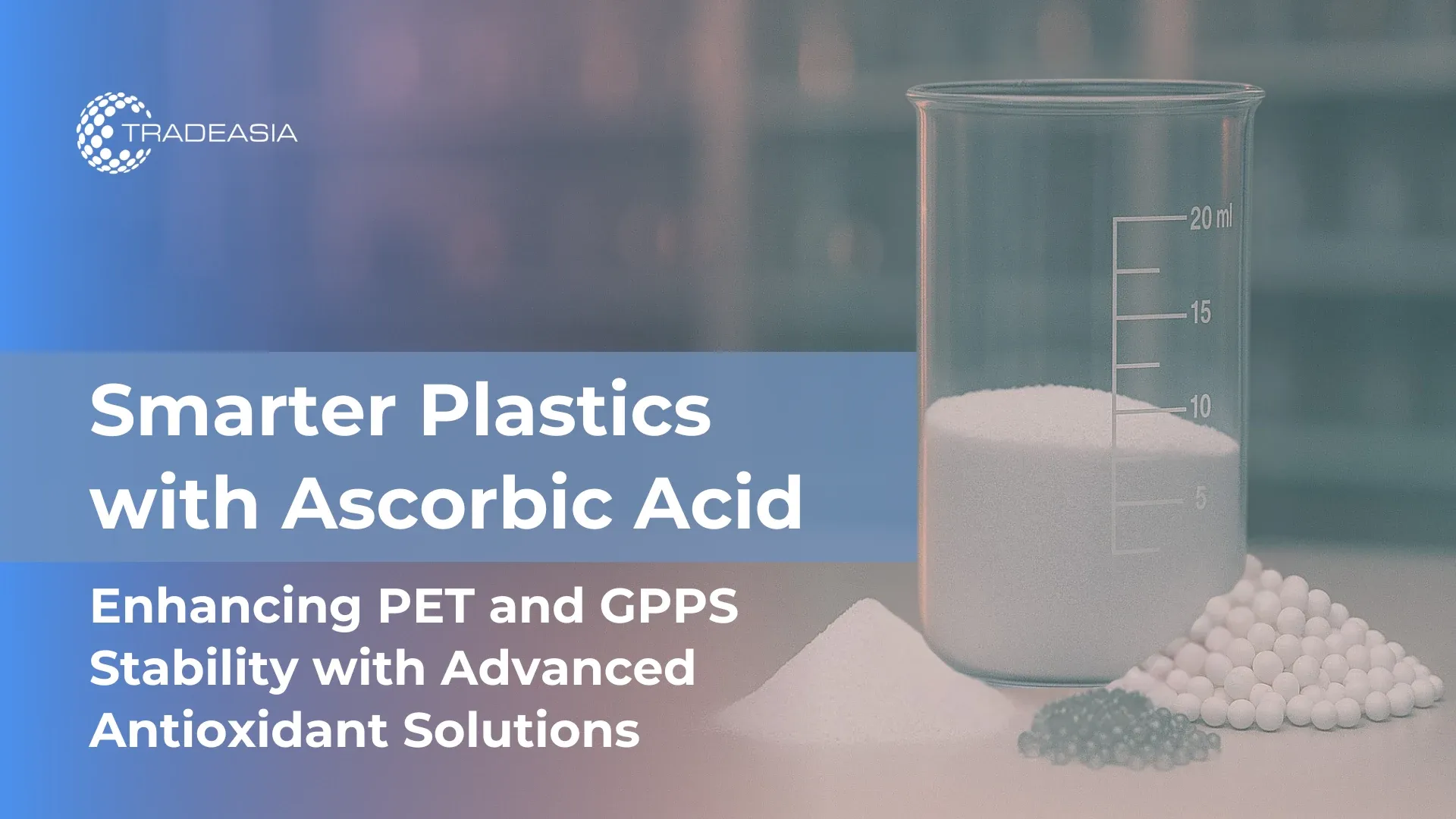1. Introduction: Why Ascorbic Acid Matters in Plastics
Ascorbic acid, commonly known as vitamin C, is more than a nutrient—it’s also an industrial-grade antioxidant that enhances the durability of plastics. In the plastic industry, its role as a stabilizing additive has gained attention for mitigating polymer degradation and discoloration during heat processing. For detailed specification about Ascorbic Acid visit Food Additive Asia by Tradeasia.
Plastic oxidation is one of the main challenges manufacturers face, especially for polymers like PET and GPPS that require transparency and strength. When oxygen interacts with polymer chains, it causes brittleness and color shift. By incorporating ascorbic acid, producers can maintain clarity and mechanical stability throughout processing and storage.
Recent studies have reinforced the antioxidant efficacy of ascorbic acid in polymers, demonstrating reduced yellowing and improved UV stability in treated materials (ScienceDirect: Antioxidants for Polymers). This underlines its role as a natural substitute for synthetic stabilizers such as BHT and BHA.
For industrial sourcing and technical details, visit Plastradeasia’s PET page or reach out via the Contact Page.
2. Understanding the Role of Ascorbic Acid in Polymer Stability
Ascorbic acid stabilizes polymers by neutralizing reactive oxygen species that form during high-temperature processing or long-term exposure to light. This prevents the scission of polymer chains, preserving molecular integrity.
When used in polyethylene and polystyrene systems, ascorbic acid reduces oxidation-induced color changes. The molecule donates electrons to free radicals, halting degradation cascades that typically compromise surface gloss and transparency.
Academic literature supports these findings, noting that bio-based antioxidants offer equivalent or better stabilization performance compared to synthetic counterparts (MDPI Polymers Journal).
For polymer-grade additives and antioxidant materials, explore Plastradeasia’s Download Center.
3. Collaboration Between Ascorbic Acid and PET
In PET processing, oxidation can occur during extrusion or thermal molding, leading to molecular chain breaks and reduced mechanical strength. Ascorbic acid prevents these issues by scavenging oxygen radicals, resulting in higher intrinsic viscosity and enhanced transparency.
PET bottles, films, and fibers particularly benefit from this additive. When combined at precise concentrations, ascorbic acid not only preserves color but also delays degradation during recycling — an advantage for closed-loop PET systems.
Studies by polymer engineers have shown that antioxidants like ascorbic acid significantly reduce PET’s hydrolytic degradation during melt processing (ResearchGate: PET Stabilization Study).
For practical PET resin supply and compounding additives, refer to Plastradeasia’s PET product page.
4. Impact of Ascorbic Acid on GPPS (General Purpose Polystyrene)
GPPS is prized for its clarity and ease of molding but suffers from oxidative instability under heat and UV exposure. Ascorbic acid acts as a radical scavenger, preventing polymer chain cleavage and preserving visual transparency.
In manufacturing environments, GPPS with ascorbic acid additive maintains performance over repeated thermal cycles, improving product shelf life and surface gloss. This is particularly beneficial in food packaging and consumer electronics, where optical quality matters.
Further scientific evidence supports natural antioxidant efficacy in polystyrene systems (ScienceDirect: Polymer Degradation and Stability Journal). The transition toward non-toxic stabilizers reflects the market’s increasing preference for safer materials.
You can explore GPPS resin supply and specifications on Plastradeasia’s Polystyrene page.
5. Comparative Benefits Over Traditional Antioxidants
Conventional stabilizers such as BHT and BHA have long dominated the industry, but concerns about toxicity and regulatory restrictions have fueled interest in safer, bio-based alternatives. Ascorbic acid fits perfectly into this shift toward sustainable manufacturing.
Unlike synthetic antioxidants, ascorbic acid leaves no harmful residues and can be used in both food-contact and consumer applications without safety concerns. It also acts synergistically with citric acid and tocopherol, improving overall oxidation resistance.
An overview from the European Bioplastics Association confirms the ongoing industry transition toward bio-based stabilizers (European Bioplastics). This global shift supports long-term market potential for ascorbic acid adoption in polymer systems.
6. Industrial Applications and Market Potential
Ascorbic acid finds extensive application in PET packaging, polystyrene products, and high-performance polyethylene compounds. In PET bottles, it prevents yellowing and extends storage stability. In GPPS, it enhances clarity and structural retention.
Asian manufacturers, particularly in India, Singapore, and Indonesia, are adopting bio-based antioxidants to comply with sustainability mandates and consumer expectations. Tradeasia supports these transitions with a robust global chemical distribution network.
The Plastics Europe association notes that polymer antioxidants market growth is driven by increasing regulations on VOC emissions and health safety (Plastics Europe). These industry dynamics create favorable conditions for natural additives like ascorbic acid.
7. Sustainable Plastic Manufacturing with Ascorbic Acid
Sustainability in plastics manufacturing requires a balance between performance and recyclability. Ascorbic acid contributes to this goal by reducing degradation and enabling multiple melt cycles without property loss.
When applied in PET and GPPS, ascorbic acid enhances color stability and reduces carbon footprint by lowering additive toxicity. Its adoption is growing in circular economy initiatives where waste reduction and clean production are prioritized.
For further reading on sustainable polymer additives, refer to Nature: Green Additives in Polymers. This academic analysis supports the use of antioxidants like ascorbic acid for eco-efficient material production.
Tradeasia, through Plastradeasia.com, plays a key role in distributing polymer-grade chemicals and additives for global clients seeking sustainability compliance.
8. Conclusion: The Future of Polymer Innovation
The collaboration of ascorbic acid with PET and GPPS defines a new era for eco-smart polymer engineering. By integrating a natural antioxidant, manufacturers enhance product durability, safety, and environmental compatibility.
Industry data suggests continued adoption of bio-based stabilizers across packaging, automotive, and consumer goods sectors — where both performance and regulatory compliance drive procurement decisions.
For businesses seeking reliable polymer additives or resin materials, Plastradeasia provides end-to-end sourcing and technical documentation through its Download Center and Contact Portal.


Leave a Comment